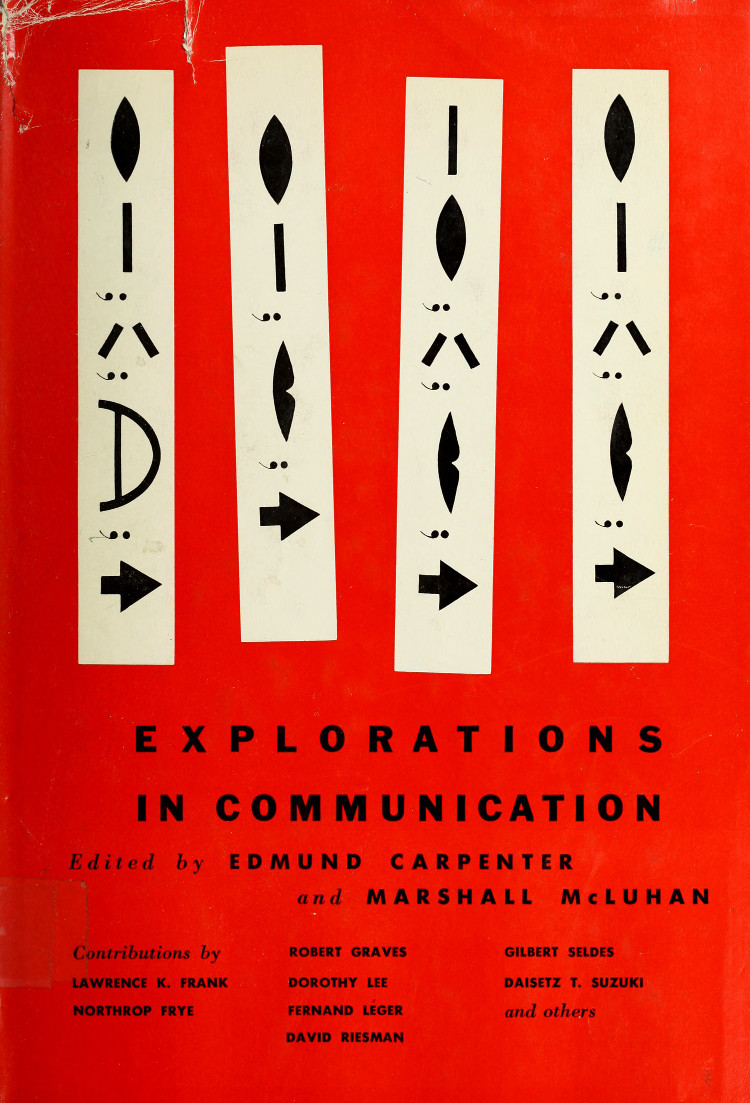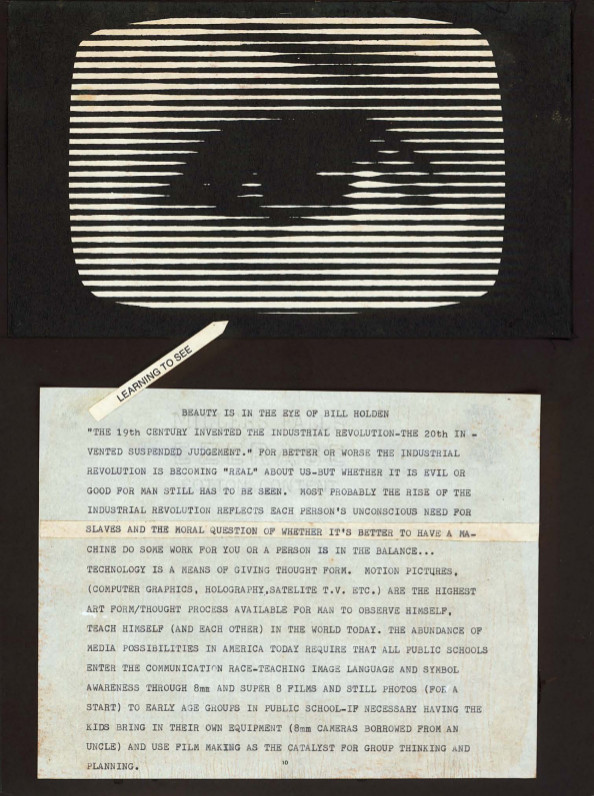Edmund Carpenter, Marshall McLuhan (eds.): Explorations in Communication: An Anthology (1960–) [EN, ES]
Filed under book | Tags: · communication, communication technology, language, mass media, media, media theory, print, technology, television

“This book explores the form and dynamics of communication to discover how it works – how human beings exchange feelings, facts, fancy. What makes words, sentences and grammars meaningful? What is the difference between the private world of reading and the instant “togetherness” of television audiences? How does the inner structure of communication vary from society to society?
These essays by world-famed scholars and artists cover the whole range of communications media — from skin touch to voice inflection, from newsprint to electronic devices, from primitive grammars to films. Here we step outside the various media by examining one through another. Print is seen from the perspective of electronics; television is analyzed through print — and thus literacy’s role in shaping man is brought into sharp new focus.
The contemporary revolution in the packaging and distribution of ideas and feelings makes a new view of communication imperative. To give voice to such views, the journal Explorations was begun in Toronto in 1953, financed by the Ford Foundation and the Toronto Telegram. From the start, the magazine won high praise from the academic world. The articles in this book, all of which appeared in Explorations, represent some of the most original research now in print on problems that will confront us for many years to come.” (from front flap)
With contributions by Ray L. Birdwhistell, Edmund Carpenter, H. J. Chaytor, Lawrence K. Frank, Northrop Frye, Arthur Gibson, Sigfried Giedion, Stephen Gilman, Robert Graves, Stanley Edgar Hyman, Dorothy Lee, Fernand Léger, Marshall McLuhan, David Riesman, W. R. Rodgers, Gilbert Seldes, Jean Shepherd, Daisetz T. Suzuki, Jacqueline Tyrwhitt.
Publisher Beacon Press, Boston, 1960
Issue 218 of Beacon series in Contemporary Communications
210 pages
via Archive.org
Explorations in Communication: An Anthology (hi-res, 181 MB, no OCR), Lower-res version (67 MB, OCR, via Steve McLaughlin), Other formats
El aula sin muros investigaciones sobre técnicas de comunicación (Spanish, trans. Luis Carandell, 2nd ed., 1968/1974, added on 2014-3-6)
Stephen Harper: Beyond the Left: The Communist Critique of the Media (2012)
Filed under book | Tags: · capitalism, communism, democracy, fascism, journalism, left, marxism, mass media, migration, neoliberalism, politics, television, wikileaks

Attacking the cherished assumptions of liberal media criticism, Beyond the Left updates and recharges the Marxist critique of the media.
The ideological distortions of the conservative media, from Fox News to the Daily Mail, are widely acknowledged and often denounced among contemporary critics and commentators. But what if The Guardian newspaper and BBC news, in fact, constitute the most insidious forms of capitalist propaganda? In a wide-ranging and erudite polemic, Beyond the Left analyses capitalist news and current affairs media from a radical perspective. The book rejects the liberal and pluralist paradigms that often underpin critiques of the media, showing how media texts reflect and reinforce the material interests of the ruling class and arguing that the principal ideological menace today is posed not by the right wing, but by the left-liberal media, as it co-opts and obscures radical political positions and reinforces a range of mystifications, from anti-fascism and humanitarian war to green politics. Drawing on the work of radical media critics as well as the writings of revolutionary communist groups and considering the recent reporting of war, industrial action, immigration and the environment, Beyond the Left updates and recharges the Marxist critique of the media.
Publisher Zero Books, an imprint of John Hunt Publishing, 2012
ISBN 1846949769, 9781846949760
114 pages
review (Laura Cooke, Socialist Review)
Comment (0)Stan VanDerBeek: Violence Sonata / The History of Violence in America (1970)
Filed under artist publishing | Tags: · art, collage, education, machine, mass media, media, participation, performance, technology, television, violence

Stan VanDerBeek was part of the “Rockefeller Artists-in-Television” residency program at Boston public television station WGBH from 1969–1970, during which time he produced the simulcast television program Violence Sonata. The program, directed by David Atwood and Fred Barzyk, was transmitted simultaneously on both Channels 2 and 44 on January 12, 1970, with the suggestion that viewers place two television sets side-by-side. Following sonata form, the piece is composed of three segments: “Man,” “Man to Woman,” and “Man to Man.” The simultaneous broadcast consisted of material VanDerBeek composed from previous films, archival and newsreel footage, video shot in Boston for the show, and filmed collages, further manipulated and enhanced through overlays and color saturation. Sections of the broadcast were played before a live studio audience, with actors also performing a play written by VanDerBeek for the show. Home viewers were encouraged to call in their responses to the program between the acts. The series of collages entitled The History of Violence in America was conceived as layouts for reproduction and publication in a booklet to accompany the broadcast.
Commentary: Melissa Ragain (X-TRA, 2012).
Video excerpt (Violence Sonata)
PDF (Violence Sonata – script, photo documentation, sketches, collages, reviews)
PDF (The History of Violence in America, 22 pages)

